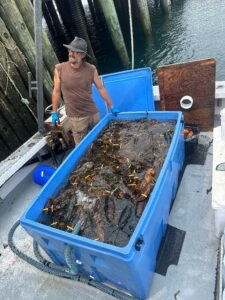PROVINCETOWN — Since 1997, lobstermen along the Eastern seaboard have had to throw back lobsters with a “V-notch” — a triangular cut in the tail of an egg-bearing female that establishes it as uncatchable breed stock.

Until last month, the notch rules differed depending upon whether a fisherman had a federal permit or a state one. Federal permits allow lobstermen to fish farther offshore but have a tighter notch size restriction. Federal permit holders could harvest only lobsters with notches measuring 1/8-inch or less — the idea being that these lobsters had more time to grow, molt, and reproduce by the time they were taken. State permit holders could take lobsters with notches of up to ¼-inch.
As of July 1, an addendum to the Atlantic States Marine Fisheries Commission (ASMFC) lobster management plan calls for the smaller notch size for all lobster permit holders.
The change is meant to expand protection of the spawning stock, according to the text of the addendum. The measure also seeks to “resolve discrepancies between the regulations for state and federal permit-holders,” the document says.
But the Outer Cape’s lobstermen who hold state permits say that the rollover to the federal permit holders’ rule should not apply to them. That’s the majority of lobstermen here: there are 64 commercial lobster permits issued to Outer Cape fishermen, and 41 are state-only permits, according to Julia Hopkins, a spokesperson for the Mass. Dept. of Fish & Game.
Outer Cape lobstermen say they worked out an exception years ago that promised them that V-notching would be optional for fishermen working in this area in exchange for their having a larger minimum size requirement. They say this was agreed with the Atlantic States Marine Fisheries Commission because it made for better conservation in local waters.
The lobstermen maintain their exception should hold, even with the ASMFC rule change. But according to the commission, no such exception was ever made.
Lobstermen say complying with the new 1/8-inch rule has forced them to toss back about a fourth of what they catch.
The change didn’t come as a surprise. Since last winter, the roughly 40-member Outer Cape Lobstermen’s Association has been holding regular meetings to organize a campaign against it. Now, the association is seeking a federal injunction against the rule. They argue it violates an out-of-court settlement they reached with the ASMFC in 2000.
The ASMFC responded by moving to dismiss the case on June 24 on the grounds that no such settlement had been reached. As of Aug. 11, the case is awaiting a decision by Judge William G. Young, who presided over the proceeding that led to the original settlement.
Marking the tails of egg-bearing lobsters has been practiced in Maine since the early 20th century and was brought to the rest of the East Coast when the ASMFC took over lobster management. It’s based on the idea that because lobsters shed their shells as they grow, any mutilations will be filled in over time. Young lobsters molt much more frequently than old ones, with adult females molting about once every two years, according to the University of Maine’s Lobster Institute.
Mike Packard, a commercial lobster diver in Provincetown, said that the change has forced him to throw back about 15 to 20 percent of his harvest.
Sam Pickard, a lobsterman from Wellfleet, estimated he’s throwing back more — around 28 percent. Pickard, who is vice president of the Outer Cape Lobstermen’s Association, said it was rare for local lobstermen to keep track of how many lobsters they threw back before the rule change.
At that time, “We were only throwing away the fresh V-notches, the ones that had not had a chance to molt a couple of times and reproduce,” he said.
The new rule is the same standard federal permit holders on the Outer Cape had been held to since 2010.
When it was first approved in May 2023, the rule change also called for increases in the minimum size for harvestable lobsters in management areas 1 and 3, which constitute the Gulf of Maine and the offshore Atlantic as far south as Virginia. Those were repealed in May 2025 following objections from commercial fishermen in those areas.
Preemptive conservation measures were needed because what’s called the “settlement index” for lobsters was trending down, according to Beth Casoni, executive director of the Mass. Lobstermen’s Association. The index is part of an annual monitoring program that looks at the numbers of juvenile lobsters, or recruits, present in coastal nursery areas.
According to the ASMFC, the lobster stock in southern New England is currently the lowest on record, based on a 2020 benchmark assessment. Meanwhile, the population in the Gulf of Maine is near a record high. The ASMFC reports that overfishing is not occurring in either area.
Casoni isn’t sure what’s caused the population decline here. “There is something happening between the surface water and where the lobster larvae start to settle to the bottom where they grow,” she said. “We need to know more about this.”
Mike Rego, a Provincetown lobsterman who has a federal permit and fishes in Area 1 but used to fish in the Outer Cape area, says he thinks the population changes are caused by warmer water temperatures because of climate change. He says commercial draggers could also be affecting the population.
“But everything goes in cycles,” Rego said. “This year, I’ve seen more 5-to-6-inch lobsters than I’ve ever seen.”
Rego thinks the new rule is unfair. Of his colleagues fishing with state permits, he said, “Those guys are getting screwed.”
“Because we’re the little guys, we keep getting penalized,” Pickard said. “We’ve gone to the meetings, we’ve talked to the state, we’ve talked to the federal government, talked to the ASMFC, and they push through anyway.”
For Pickard, the need to reconvene the Outer Cape Lobstermen’s Association and pool money to hire a lawyer is indicative of how consequential the change is. “The only time we get together is when we have a problem,” he said. “We had healthy permits, healthy fishermen. Everybody was happy.”



